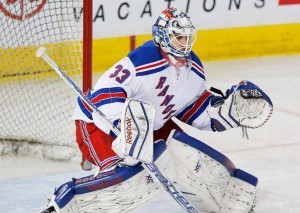With the Draft approaching and everyone’s attention turning to off-season business, Ranger fans have fixated on a report from TSN’s Darren Dreger (here and here) regarding significant interest around the league in Cam Talbot. He is apparently the top choice for a number of teams for their goaltending vacancies; Edmonton, San Jose, Calgary, Florida, Buffalo and Dallas, have all been named as potential suitors.
This is great news for the Rangers. A short time ago, we were talking about a second round pick representing solid value for the one-time undrafted free agent. Now, there is chatter about Talbot’s value being as high as a mid-first round pick. That would be quite the coup. This development has created an interesting debate in real versus perceived value.
I’m not going to give you a microeconomics lesson in supply and demand. If you’re a GM looking for a starting netminder for your club in free agency, the pickin’s are slim. You have a thoroughly-mediocre Antti Neimi or the relatively unproven Karri Ramo. Beyond that, it’s a low-rent buffet of fringe-to-decent backups and burnt out prospects. Unless you feel like throwing a massive offer sheet at Braden Holtby, a trade is by far the best option out there.
The concept of “selling high” is largely a myth in pro sports. A few hot weeks generally don’t move the dial for teams weighing the use of their resources. They have their own internal valuations of trade targets and act accordingly. However, this is something of a unique situation.
The interesting thing about Talbot is that there are several factors working to artificially increase his stock. First of all, he is very much on the right side of thirty (turning 28 in a few weeks) on a dirt cheap contract for a starter. Not only that, his relatively limited track record and earnings project to allow the trading team to extend him on a reasonable terms without eating too many decline years. Although his sample size is small, his numbers have been excellent, and you may even have some organizations buying his performance to date as some actual approximation of his talent level. Lastly, Talbot’s molten hot run last year came in relief of one of the league’s best goaltenders in the biggest market. Let’s face it, had Cam come in and dominated in relief of say, Mike Smith, I don’t think his value would be nearly as high. Perception plays a big part.
The risk, of course, is that Talbot is not an above-average starter when the chips are down. He has 57 career games of NHL experience, not even a full starters workload for one season (no fault of his own, obviously). When you look at the mechanical adjustments he has made since turning pro, he has Beniot Allaire’s fingerprints all over him. He now plays deeper in his net with much less noise in his movement. You have to wonder about potential regression without Allaire’s tutelage.
When you look at those potentially interested teams, they are either trying to turn a corner (Buffalo, Edmonton, Florida) or trying to reverse course from shaking goaltending situations (Dallas, Calgary, SJ). When trying to build a franchise contender, some risk is a necessity to putting all the pieces in place. For a GM who scrambling to find the right guy in a barren market, opportunity has to be created. All of these factors have the potential to coalesce in a bidding war for a player with a very short track record of elite play, with some questions about where his true talent level ultimately lies.
In a slightly off-topic digression, I just want to put my $.02 in on this issue. From a Rangers perspective, trading Talbot over looking to move Henrik Lundqvist’s contract is an absolute no-brainer. Economic factors of finding a team prepared to allocate $8.5 million of cap space to a goaltender aside, Henrik is the flat-out better goaltender. There is really no intelligent debate about it. Whether you are looking at long-term numbers, subjective performance analysis or simply athletic tools, Lundqvist is the superior player in every facet of the game (except puck handling). The only knocks on him are his age and contract. Give me the future Hall of Famer.
None of this is to say that Talbot ultimately won’t end up being a very good goaltender for the acquiring team. His improvement in play since he was signed has tangible evidence backing it up. If you watch him during his first year in Hartford versus this past season, you would be surprised you were looking at the same goaltender. His commitment to realizing his potential has paved the way for a productive NHL career.
I guess the point of all of his is that there is seemingly a significant gap between the real and perceived value of Cam Talbot. In this case, market forces seem to be driving his price tag up, and that is nothing but a good thing for the Rangers. We can debate the merits of a first round pick v. a few mid-round picks v. prospects, but at the end of the day, the Rangers organization has turned an incredibly cheap amateur acquisition into a legitimate asset to improve the roster going forward. Hopefully Sather can work his trade magic and help bring some cap relief, depth and balance to the roster this off-season. No matter what the return, this will be a fascinating story to follow as we move toward the Draft.
Share:
More About:Goaltending Offseason Trades

